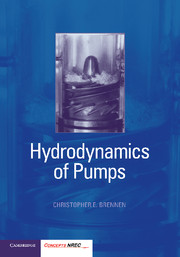Book contents
- Frontmatter
- Contents
- Preface
- Nomenclature
- 1 Introduction
- 2 Basic Principles
- 3 Two-Dimensional Performance Analysis
- 4 Other Flow Features
- 5 Cavitation Parameters and Inception
- 6 Bubble Dynamics, Damage and Noise
- 7 Cavitation and Pump Performance
- 8 Pump Vibration
- 9 Unsteady Flow in Hydraulic Systems
- 10 Radial and Rotordynamic Forces
- Bibliography
- Index
10 - Radial and Rotordynamic Forces
Published online by Cambridge University Press: 04 February 2011
- Frontmatter
- Contents
- Preface
- Nomenclature
- 1 Introduction
- 2 Basic Principles
- 3 Two-Dimensional Performance Analysis
- 4 Other Flow Features
- 5 Cavitation Parameters and Inception
- 6 Bubble Dynamics, Damage and Noise
- 7 Cavitation and Pump Performance
- 8 Pump Vibration
- 9 Unsteady Flow in Hydraulic Systems
- 10 Radial and Rotordynamic Forces
- Bibliography
- Index
Summary
Introduction
This chapter is devoted to a discussion of the various fluid-induced radial and rotordynamic forces which can occur in pumps and other turbomachines. It has become increasingly recognized that the reliability and acceptability of modern turbomachines depend heavily on the degree of vibration and noise which those machines produce (Makay and Szamody 1978), and that one of the most common sources of vibration is associated with the dynamics of the shaft and its related components, bearings, seals, and impellers (Duncan 1966–67, Doyle 1980, Ehrich and Childs 1984). It is clear that the modern pump designer (see, for example, Ek 1978, France 1986), or turbine designer (see, for example, Pollman et al. 1978), must pay particular attention to the rotordynamics of the shaft to ensure not only that the critical speeds occur at expected rotational rates, but also that the vibration levels are minimized. It is, however, important to note that not all shaft vibrations are caused by rotordynamic instability. For example, Rosenmann (1965) reports oscillating radial forces on cavitating inducers that are about 20% of the axial thrust, and are caused by flow oscillations, not rotordynamic oscillations. Also, Marscher (1988) investigated shaft motions induced by the unsteady flows at inlet to a centrifugal impeller operating below the design flow rate.
Texts such as Vance (1988) provide background on the methods of rotordynamic analysis. We focus here only on some of the inputs which are needed for that analysis, namely the forces caused by fluid motion in the bearing, seal, or impeller.
- Type
- Chapter
- Information
- Hydrodynamics of Pumps , pp. 209 - 252Publisher: Cambridge University PressPrint publication year: 2011



